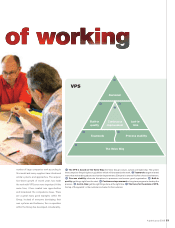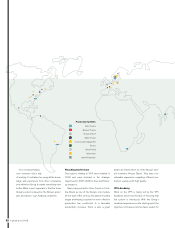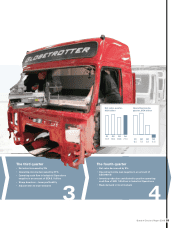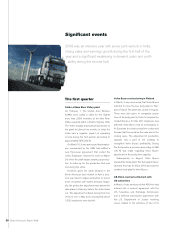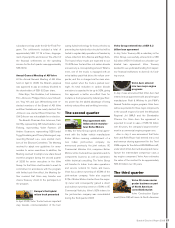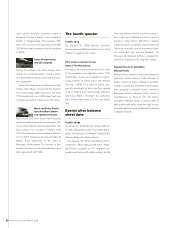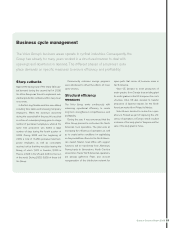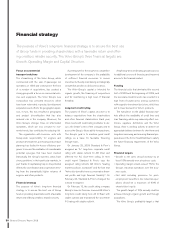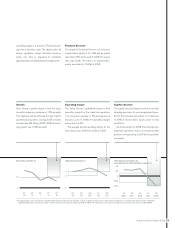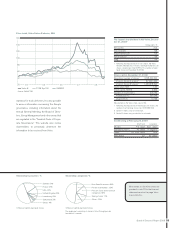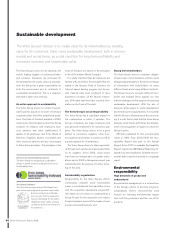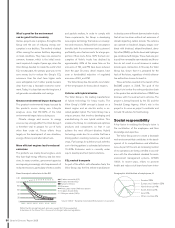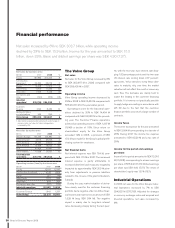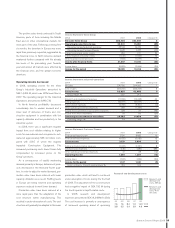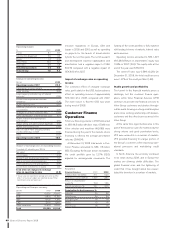Volvo 2008 Annual Report Download - page 34
Download and view the complete annual report
Please find page 34 of the 2008 Volvo annual report below. You can navigate through the pages in the report by either clicking on the pages listed below, or by using the keyword search tool below to find specific information within the annual report.
Financial strategy
The purpose of Volvo’s long-term fi nancial strategy is to ensure the best use
of Group funds in providing shareholders with a favorable return and offer-
ing creditors reliable security. The Volvo Group’s three fi nancial targets are:
Growth, Operating Margin and Capital Structure.
Focus on commercial
transport solutions
The streamlining of the Volvo Group, which
commenced with the sale of passenger car
operations in 1999 and continued in the form
of a number of acquisitions, has created a
strong group with a focus on commercial vehi-
cles and equipment. The Volvo Group’s new
composition has provided resources which
have been reinvested in product development,
acquisitions and efforts for geographic expan-
sion. In turn, this has resulted in geographic
and product diversifi cation that has also
reduced risk in the company. Moreover, the
Volvo Group’s stronger focus on aftermarket
operations, which are less sensitive to eco-
nomic trends, has contributed to reducing risk.
The organization with business units with
Group-wide responsibility for engines and
product development, purchasing and product
planning has fuelled in-house effi ciency pro-
grams to ensure the realization of considerable
potential synergies that have been created.
Individually, the Group's business areas have
strong positions in their particular markets, in
part thanks to capitalizing fully on the potential
offered for coordination and cooperation deriv-
ing from the dramatically higher volumes of
engines and other products.
Financial strategy
The purpose of Volvo’s long-term fi nancial
strategy is to ensure the best use of Group
funds in providing shareholders with a favorable
return and offering creditors reliable security.
A prerequisite for the long-term competitive
development of the company is the availability
of suffi cient fi nancial resources to secure
investments, thereby maintaining a strategically
competitive position in all business areas.
The Volvo Group’s capital is intended for
organic growth, the fi nancing of acquisitions
and for maintaining a high level of fi nancial
fl exibility.
Long-term credit rating
The purpose of Volvo’s capital structure is to
balance expectations from the shareholders
and other fi nancial stakeholders. Each year,
Volvo meets with credit rating institutes to dis-
cuss the lender’s view of the company and to
assess the Group’s future ability to repay loans.
The Group’s goal is to maintain good credit
ratings as a base for favorable fi nancing
through loans.
On January 23, 2009 Standard & Poor’s
assigned an “A-“ long-term corporate credit
rating with stable outlook for AB Volvo and
affi rmed the A2 short-term rating. In their
credit report Standard & Poor’s says the
assigned rating refl ects AB Volvo’s “leading
market positions worldwide” and the fact that
“Volvo also benefi ts from a conservative fi nan-
cial profi le and high fi nancial fl exibility”. On
February 20, Standard & Poor's changed the
outlook to negative.
On February 13, the credit rating company
Moody’s Investor Services lowered AB Volvo's
long-term credit rating from A3 to Baa1 with
stable outlook and maintained the short-term
P-2 rating with stable outlook.
A high long-term credit rating provides access
to additional sources of fi nancing and improved
access to the fi nancial market.
Funding
The fi nancial crisis that dominated the second
half of 2008 and the beginning of 2009, and
the associated credit crunch, has resulted in a
high level of cautiossness among customers
with regard to investment decisions, which has
led to lower demand for Volvo’s products.
The turbulence on the global fi nancial mar-
kets affects the availability of credit lines and
loan fi nancing, which may adversely affect cus-
tomers, suppliers, distributors and the Volvo
Group. Volvo is working actively to achieve an
appropriate balance between its short-term and
long-term borrowing, and ensuring fi nancial pre-
paredness in the form of credit facilities to satisfy
the future fi nancing requirements of the Volvo
Group.
Financial targets
– Growth in net sales should increase by at
least 10% annually over a business cycle.
– Operating margin should exceed 7% for the
Group's industrial operations over the busi-
ness cycle.
– Net debt including provisions for post-
employment benefi ts in the industrial oper-
ations should be a maximum of 40% of
shareholders’ equity.
The growth target of 10% annually shall be
achieved through organic growth and through
acquisitions.
The Volvo Group’s profi tability target is that
30 Board of Directors’ Report 2008



